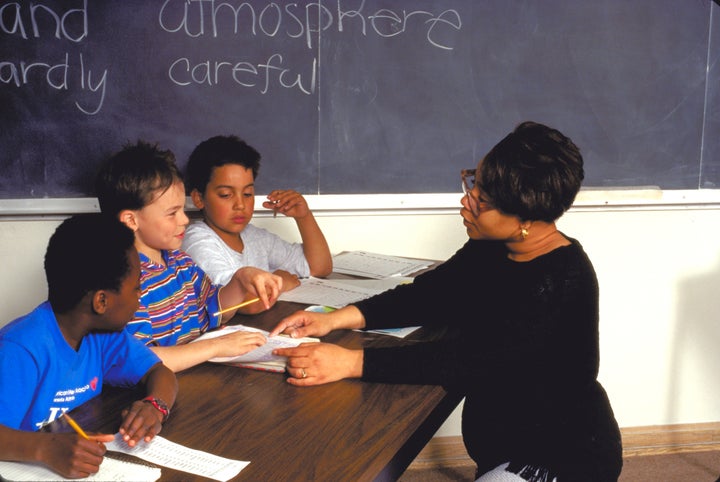
Minority students will likely outnumber white students in the next decade or two, but the failure of the national teacher demographic to keep up with that trend is hurting minority students who tend to benefit from teachers with similar backgrounds.
Minority students make up more than 40 percent of the national public school population, while only 17 percent of the country's teachers are minorities, according to a report released this week by the Center for American Progress.
"This is a problem for students, schools, and the public at large. Teachers of color serve as role models for students, giving them a clear and concrete sense of what diversity in education--and in our society--looks like," the report's authors write. "A recent review of empirical studies also shows that students of color do better on a variety of academic outcomes if they're taught by teachers of color."
Using data from the 2008 Schools and Staffing Survey, the most recent data available, researchers found that more than 20 states have gaps of 25 percentage points or more between the diversity of their teachers and students.
California yielded the largest discrepancy of 43 percentage points, with 72 percent minority students compared with 29 percent minority teachers. Nevada and Illinois had the second and third largest gaps, of 41 and 35 percentage points, respectively.
In a second report, the CAP notes that in more than 40 percent of the nation's public schools, there are no minority teachers at all. The dearth of diversity in the teaching force could show that fewer minorities are interested in teaching or that there are fewer minorities qualified to teach.
"Increasing the number of teachers of color is not only a matter of a philosophical commitment to diversity in career opportunities. Teachers of color provide real-life examples to minority students of future career paths," the researchers write. "In this way, increasing the number of current teachers of color may be instrumental to increasing the number of future teachers of color. And while there are effective teachers of many races, teachers of color have demonstrated success in increasing academic achievement for engaging students of similar backgrounds."
This large discrepancy between minority teachers and minority students can be attributable to low graduation rates among many minority groups, according to the report. While high school graduation is a minimum requirement for the teaching profession, just over half of black, Latino and Native American students finish high school. College entrance and completion rates are similarly low -- with only 56 percent of black students and 64 percent of Latino high school graduates going on to college. Less than half of both black and Latino students finished college in 2007.
In addition, the high cost of college also drives many minority students away from pursuing higher education.
In an August Huffington Post report, Enrique Murillo, a professor of education at California State University, San Bernardino, said the disparity "has created a cultural and linguistic gulf" that especially hurts students who take English as a second language. Murillo is also commissioner of the California Student Aid Commission and executive director of Latino Education and Advocacy Days.
"There's so few of us in general in the educational pipeline, so the pool is really small," Murillo told HuffPost. "It stems from the overall crisis in Latino education. The main crux here is that there's a mismatch between school and home, and Latino educators are bridge builders that help close that mismatch."
CAP's paper reports several case studies of initiatives that aim to increase teacher recruitment and retention among those groups, including Teach for America and The New Teacher Project-Fellowship Programs.
- Increasing federal oversight of and increased accountability for teacher preparation programs. This is the first step in ensuring that minority teachers emerge from teacher preparation programs with the skills needed to be effective teachers. The federal government can also take the lead on requesting programs to report on diversity efforts.
- Creating statewide initiatives to fund teacher preparation programs aimed at low-income and minority teachers.
- Strengthening federal financial aid programs for low-income students entering the teaching field.
- Reducing the cost of becoming a teacher by creating more avenues to enter the field and increasing the number of qualified credentialing organizations.
- Strengthening state-sponsored and nonprofit teacher recruitment and training organizations by increasing standards for admission, using best practices to recruit high-achieving minority students, and forming strong relationships with districts to ensure recruitment needs are met.